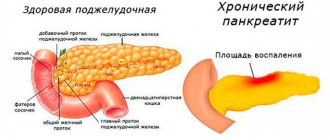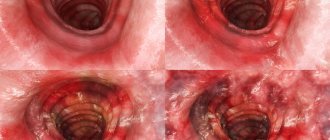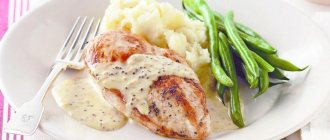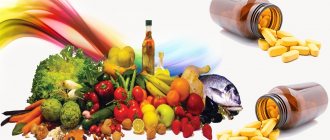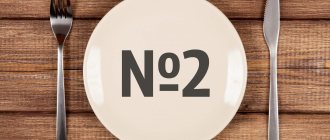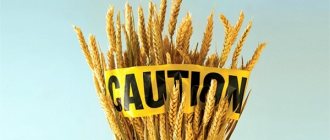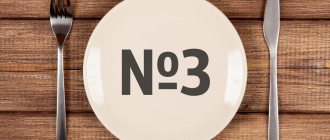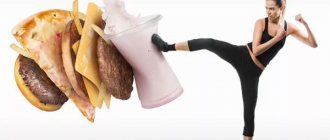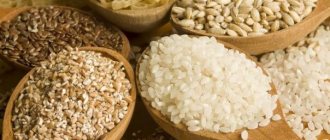Gastroduodenitis is a disease of the gastrointestinal tract, which is characterized by the occurrence of an inflammatory process in the mucous membrane of the stomach and duodenum. The disease occurs in acute or chronic form. Diet therapy for gastroduodenitis is the basis for the treatment of this disease. Following a diet allows you to relieve the inflammatory process on the mucous membrane and prevent complications from developing.
Nutrition for chronic gastroduodenitis
In case of chronic gastroduodenitis, it is necessary to avoid eating fatty, spicy and salty foods. Preference should be given to lean types of meat and fish: young beef, veal, rabbit, turkey and chicken. Salted fish, offal, goose, duck and lamb should be excluded. Nutrition should be as gentle as possible. It is preferable to boil or stew food rather than fry it.
If you have
a chronic
form
of gastroduodenitis
, then you should regularly
carry out preventive treatment
.
Menu (Power Mode)
Several options for diet table menu No. 1
First option
| Breakfast |
|
| Lunch |
|
| Dinner |
|
| Afternoon snack |
|
| Dinner |
|
| Before bedtime |
|
Second option
| Breakfast |
|
| Lunch |
|
| Dinner |
|
| Dinner |
|
| Before bedtime |
|
Third option
| Breakfast |
|
| Lunch |
|
| Dinner |
|
| Afternoon snack |
|
| Dinner |
|
| Before bedtime |
|
Dietary nutrition during exacerbation of gastroduodenitis is prescribed for 21 days, but depending on the patient’s complaints, individual characteristics of the body and objective examination data, it may vary. The length of time spent on a specific type of diet is determined in each specific case.
Sample menu for exacerbation of hypoacid gastroduodenitis (table No. 2)
Therapeutic nutrition for hypoacid gastroduodenitis is more expanded: the menu includes first courses that are prepared in richer meat/fish, mushroom, vegetable broth (soup, pickle, borscht) with the inclusion of various vegetables, potatoes, and cereals.
Second courses can be prepared using various technologies (boil, fry, bake) in the form of pieces of meat, fish or meatballs and cutlets, vegetables - in the form of casseroles and purees (white cabbage, potatoes, beets, carrots, zucchini, pumpkin, green peas. cauliflower).
The diet includes cottage cheese, various fermented milk products, vegetable and fruit juices diluted with water, bran decoctions, pureed sweet and sour fruits and berries.
Types of diets for gastroduodenitis:
For gastroduodenitis, diet No. 1, diet No. 5, diet No. 2 are prescribed.
Diet No. 1 is prescribed for high acidity. For gastroduodenitis with high acidity, preference should be given to pureed dishes, slimy soups, and boiled porridge with milk. Meals should be fractional, at regular intervals. It is important to chew all food thoroughly.
Table No. 2 is prescribed for gastroduodenitis with low acidity (atrophic gastroduodenitis). Meals should be fractional, at regular intervals. Solid and liquid foods are taken separately. Be sure to follow the drinking regime - at least 1800 ml. fluids per day
Diet No. 5 is necessary for all people suffering from chronic gastroduodenitis for daily nutrition without exacerbation. If you have been diagnosed with chronic gastroduodenitis, then diet No. 5 is the diet that you need to adhere to throughout your life. It will no longer be possible to return to unhealthy, fried, spicy foods, or fast food. Any violation of the diet will lead to an exacerbation of the disease.
General rules
Gastroduodenitis is a combined inflammation of the mucous membrane of the lower part (pyloric section) of the stomach and the upper part of the duodenum. It is the anatomical proximity of these organs, and often the commonality of etiological factors (the presence of Helicobacter ), that contributes to the secondary involvement of the duodenal mucosa in the pathological process. This disease is a type of chronic gastritis .
There are acute and chronic forms of the disease, but at the everyday level, most people by gastroduodenitis mean a chronic form of the disease, which lasts for a long time with alternating periods of remissions and exacerbations, which are perceived as “acute gastroduodenitis”.
Diet for gastroduodenitis is the most important component of the treatment process and depends on the form and type of the disease (superficial “catarrhal”, erythematous, erosive gastroduodenitis), as well as gastric pH-metry . The general principles of nutrition for gastritis and duodenitis are: maximum sparing of the mucous membrane of the compromised organ from any type of damaging factors. This is achieved by excluding from the diet foods that require long-term digestion; food is served in a homogenized state (boiled, ground, mushy), and it is also necessary to chew food thoroughly.
It is not allowed to serve food in an excessively hot/cold state. Foods that cause chemical irritation (fatty and fried foods, smoked meats, marinades, spices and sauces, canned food, raw vegetables, alcohol) are excluded from the diet; salt intake is limited.
List of permitted products:
| vegetables | Boiled or stewed. In the form of puree or small pieces |
| Non-fat varieties of meat and fish in pureed form (minced meat) | Can be prepared in the form of cutlets, meatballs, steamed meatballs or stewed |
| Rusks, dried bread | In small quantities. Eating dry food is strictly contraindicated |
| Low-fat fermented milk products | Cottage cheese, cheese, yogurt, cottage cheese casserole, low-fat sour cream, low-sour kefir |
| Vegetable oil, butter | Can be consumed in small quantities. |
| Cereals | During periods of exacerbation, cereals should be boiled. |
Varieties
Nutrition for chronic gastroduodenitis is prescribed according to certain schemes, sequentially depending on the form and phase of the disease, the acidity of gastric juice.
Diet for gastroduodenitis in the acute stage
Exacerbation of gastroduodenitis against the background of increased or normal acidity requires the prescription of Diet No. 1 and its varieties. On the first day, complete fasting with small amounts of liquid (boiled water, tea without sugar) is indicated. On days 2-3, the patient is transferred to Table No. 1A .
The energy value of the diet is 1800 kcal. The reduction in calorie content is carried out mainly by reducing the consumption of carbohydrates and, to a small extent, proteins and fats.
Dishes and foods that stimulate secretion and irritate the gastric mucosa are prohibited. Food is steamed or boiled, served pureed or mushy; too hot/cold dishes are not allowed. Salt intake is limited to 6-8 grams.
Meals during bed rest are fractional. Drink about 1.5 liters of liquid. On days 6-8, in order to stimulate regeneration of the gastric/pancreatic mucosa, the patient is transferred to Diet 1B .
Meals while observing semi-bed rest. The energy value is reduced mainly by limiting the amount of carbohydrates, with a normal content of proteins and fats. Soups with mucous broth. Solid, stimulating foods, cold and hot dishes are excluded.
Food is steamed or boiled and served in a homogenized state. Salt is limited. The duration of Diets 1 and 1B is determined by many factors, including the form of gastroduodenitis. Thus, with superficial gastroduodenitis, given that only the mucous membrane is involved in the inflammatory process, and the remaining structures of the stomach and intestines are functionally sufficient and not affected, the period of fasting and dietary nutrition can be relatively short.
With erosive gastroduodenitis , in which there are already defects ( erosions ) on the surface of the mucous membrane, both the duration of fasting and the length of time spent on Diets No. 1A , 1B and No. 1 . In this regard, with gastritis and erosive duodenitis, which is considered a pre-ulcerative condition, it is necessary to more strictly comply with all the requirements of therapeutic nutrition.
Next, Table No. 1 . An energetically and physiologically complete diet without pronounced mechanical sparing. Food is not wiped. The menu includes dishes with various heat treatments - boiled, stewed, baked without crust and degree of grinding. Table salt is limited slightly. Meals are fractional, in reduced portions. As the patient's condition improves, the menu expands.
Salads from boiled vegetables, mild varieties of cheese, doctor's sausage and milk sausage are allowed. Only yesterday's white bread. Among the fats, preference is given to refined olive, sunflower and flaxseed oil. For porridges, rice, oatmeal and buckwheat are recommended. You should avoid pasta. Only dietary meat (chicken, rabbit, turkey). Eggs - in the form of a steam omelet.
A small amount of low-fat cottage cheese is allowed from dairy products. The advisability of including whole milk and cream in the diet is questionable. It is useful to include vegetable juices in your diet. Eating fruits and berries raw is undesirable. New dishes are gradually introduced into the diet, portions are increased, and soon the patient is transferred to Table No. 15 .
Gastroduodenitis in the vast majority of cases occurs against the background of normal/high acidity. In cases of gastroduodenitis in patients with low acidity in the recovery stage, the patient's treatment is adjusted by prescribing Diet No. 2 . In addition to providing the patient with adequate nutrition, its task includes moderate stimulation of the secretory function of the gastrointestinal tract and normalization of the motor function of the intestinal tract. To do this, the diet increases the content of foods rich in fiber and connective tissue, and also expands the types of heat treatment of foods - baked, boiled, stewed, fried without forming a crust.
Rich mushroom, meat and fish broths are allowed. The diet includes sweet and sour vegetables and berries (strawberries, currants, raspberries, lingonberries), citrus fruits, sour dairy products, sauces based on vegetable decoctions (white sauce with lemon, sour cream, mushroom) and spices, parsley, dill, celery. The consumption of butter and refined vegetable oils is increasing. Physiologically, the diet is complete (3000 Kcal). Diet: 4-5 times without overeating. The nutrition menu for hypoacid gastroduodenitis is given in the corresponding section.
List of fully or partially restricted products:
| Sour first courses (borscht, cabbage soup) | Irritate the mucous membrane |
| Bean dishes | Cause flatulence |
| Alcoholic and carbonated drinks | Irritate the gastric mucosa |
| Smoked products | Increase secretion and lead to exacerbation of the disease |
| Canned foods | Irritate the mucous membrane of the digestive tract |
| Hot and spicy sauces | increase the secretion of bile and gastric juice |
| Fast food, food products with flavor enhancers and chemical additives. | These foods irritate the mucous membrane and are difficult to digest |
Recipes
Here are recipes for preparing some dishes at home.
First meal
Carrot soup
Eggs, carrots, flour, low-fat meat broth, butter.
Boil the carrots in the prepared broth until tender, remove them and grate them on a fine grater. Fry the flour and mix thoroughly with the carrots. Combine the resulting mixture with the broth. Boil, add lightly beaten chicken eggs, add butter.
Vegetable soup with meat broth
Broccoli, carrots, tomatoes, zucchini, meat broth, low-fat sour cream, salt.
Boil vegetables in the prepared broth until tender, add salt and sour cream.
Second courses
Baked fish with mashed potatoes
Any white lean fish, potatoes, butter, salt.
Boil the potatoes, mash, add salt and oil. Bake the condemned pieces of fish in the oven.
Chicken breast with vegetables
Steam the allowed vegetables, cook the chicken breast in a slow cooker, pour in butter.
Desserts and drinks
Berry (fruit) cheesecake
Soft cottage cheese, oatmeal, sweet berries, butter, sweetener egg, gelatin.
Grind the oatmeal in a blender and mix first with the white, and then the yolk and sweetener. Add cottage cheese and mix. Place the resulting mixture in the prepared pan (grease the walls with butter), add the gelatin previously diluted in water, mix and place in the oven for 40 minutes.
Kefir + strawberry drink
Kefir 1%, granulated sugar, strawberries (strawberries).
Rinse the berries thoroughly with water and sort. Cover with sugar for one hour. Pour in kefir and beat with a blender until thick foam. Cool.
Nutritionist comments:
Treatment with diet is a necessary condition that must be fulfilled on the path to recovery. Not a single drug, even the most effective one, according to advertising, can completely cure you without following a diet.
“The right choice of a sanatorium is a significant step towards maintaining and increasing health. “Gorny” is a resort complex that combines the experience and knowledge of Russian and Soviet balneology. The presence of modern medical equipment and innovative installations, the professionalism of the staff and love for their work will serve as the key to extending longevity,” - head doctor of the sanatorium Alexander Olegovich Karaulov.
Advantages and disadvantages
| pros | Minuses |
|
|
The need to follow a diet
Compliance with therapeutic nutrition for duodenitis can relieve unpleasant symptoms during an acute process or exacerbation (pain, nausea, vomiting). In addition, proper nutrition during the period of remission allows you to delay the exacerbation of the disease.
A diet for duodenitis refers to proper and healthy food, normalizes the functioning of the entire digestive tract, prevents complications, and also disciplines the patient. In addition, the principles of a healthy diet have a beneficial effect on the patient’s well-being and appearance.
Symptoms of duodenitis in a child
The signs of this disease are very diverse and are similar to peptic ulcers. Common symptoms are:
- severe stabbing and cutting paroxysmal pain before eating or 2-3 hours after it, localized in the stomach or right hypochondrium;
- nausea;
- sour belching;
- heartburn;
- vomit;
- sometimes constipation;
- insomnia;
- headache;
- decreased appetite;
- prostration;
- tearfulness, irritability;
- pale skin. Source: A.A. Baranov, P.L. Shcherbakov Current issues in pediatric gastroenterology // Issues of modern pediatrics. 2002. T. 1, No. 1. P. 12-16
In approximately 50% of children, the disease worsens during the off-season.
In the chronic form, a good appetite usually remains. Symptoms include heartburn, sour belching, increased thirst, abdominal pain, white coating on the tongue, and frequent constipation.
The advanced disease is characterized by weakness, rapid fatigue, belching of air, nausea and a feeling of a full stomach after eating, dull weak pain, gas formation, and diarrhea.
Preventive measures
The basis for the prevention of gastrointestinal diseases is a balanced diet. Doctors recommend that patients stop smoking and drinking alcohol. Reducing the risk of developing inflammatory processes in the duodenum is facilitated by timely treatment of pathologies of the digestive system.
In the chronic course of the disease, a child or adult will need to regularly undergo clinical examinations and take medications that help eliminate the cause of inflammation of the intestinal epithelium. In this case, a favorable prognosis is formed - the patient’s quality of life remains at a consistently high level.
Causes of gastroduodenitis
Improper nutrition can cause gastroduodenitis.
The disease can occur under the influence of both external and internal factors. External factors:
- Incorrect diet, violation of diet.
- Side effects of medications.
- Stress
- Drinking alcohol and cigarettes.
Internal factors:
- The bacterium Helicobacter pylori.
- Caries.
- Tonsillitis.
- Diseases of the endocrine system.
- Biliary tract diseases.
- Congenital pathology of the gastric mucosa.
Causes of childhood gastroduodenitis:
- Infection with salmonellosis, E. coli, campylobacter through unwashed and insufficiently processed foods: eggs, meat, seafood, vegetables.
- Rotovirus infection.
- Intestinal Giardia.
- Lactose deficiency.
- Consumption of allergenic foods.
- Drug treatment.
- Poor nutrition: consumption of sausages, chips, carbonated drinks, etc.
Prevention of gastroduodenitis
Having achieved relief, it is important to prevent the disease from returning. To do this you need to follow simple rules:
- Lead a healthy and active lifestyle.
- Continue to follow basic diet recommendations.
- Do not self-medicate.
Gastroduodenitis must be treated to prevent serious complications. Proper and healthy nutrition is an effective means for treating and preventing disease in children and adults.
Diagnostic measures
A gastroenterologist is responsible for diagnosing and drawing up a treatment plan. Additionally, you must make an appointment with an endoscopist.
Diagnostic methods:
- Examination with palpation of the abdomen, history taking.
- Clinical blood and urine tests, coprogram.
- EGDS - examination reveals hyperemia, atrophy or enlargement of the mucosa. Additionally, biomaterial is taken for histological examination.
- pH-metry is a method for determining the acidity of digestive juice.
- Electrogastroenterography, antroduodenal manometry - analysis of the motor and evacuation functions of the affected digestive organs.
- Ultrasound of the abdominal organs, duodenal intubation. Prescribed to identify concomitant diseases - pancreatitis, hepatitis, cholecystitis.
- X-ray with contrast. Erratic, hyperactive peristalsis and periodic spasms are observed. The folds of the intestine are reduced or enlarged. Sometimes congestion and signs of gastroesophageal reflux are observed.
- Tests for Helicobacter pylori - breath testing, polymerase chain reaction, stool enzyme immunoassay.
Differential diagnostics are carried out to exclude peptic ulcer, spasm of the sphincter of Oddi, pancreatitis, cholecystitis, cancer of the duodenal papilla, hiatal hernia.
General information about the disease
This inflammatory disease often occurs accompanied by cholecystitis or gastritis . It can also cause problems with the liver, stomach ulcers, and inflammation of the intestines and pancreas. If left untreated for a long time, gastroduodenitis develops, that is, the stomach is also affected.
Duodenitis in children is usually a chronic disease with periods of exacerbations and remissions. As a result, pathological changes in the mucous membrane are formed. The development of the disease is most often provoked by an incorrect diet and a violation of the diet. Sometimes the causes are cardiovascular, pulmonary pathologies, allergic status, giardiasis.
The peculiarity of the disease is its similarity to gastritis, peptic ulcer, damage to the pancreas and biliary tract. Therefore, differential diagnosis is required.
Often in the acute stage, duodenitis causes complications , as in adults: stenosis, duodenostasis, bleeding, perigastritis , disturbance of intestinal motility (the process of contraction of its walls to move feces).
Rarely, the disease is localized to a specific area of the mucosa without spreading. This form is called “bulbit”.
Symptoms of acute and chronic duodenitis
If we talk about the disease as a whole, the inflammatory process usually proceeds sluggishly, manifesting itself as disturbances in appetite and general well-being and some dyspeptic symptoms (for example, rumbling in the stomach, flatulence). Patients often seem to be self-absorbed and irritated. Children are usually “skinny” and grow poorly. But the clinical picture of duodenitis can develop quite rapidly, especially with concomitant infection with Giardia.
Acute duodenitis. Suddenly and, as a rule, after a heavy overeat, an attack of severe abdominal pain may occur, from which patients literally writhe. The pain is not relieved by any medications. The patient's face becomes covered with beads of sweat. Repeated vomiting may initially suggest acute pancreatitis, but a dry and white-coated tongue clearly indicates peritoneal irritation, leukocytosis and low-grade fever. All these symptoms leave doctors no choice: the only way out is surgical intervention. So, sometimes an accurate diagnosis is made on the operating table - acute duodenitis.
Symptoms of acute duodenitis also include pain and a feeling of fullness in the stomach area (the so-called epigastric region), excessive salivation, nausea and vomiting, and loss of appetite. Body temperature often rises. The attack may be accompanied by headaches, weakness and arterial hypotension.
Chronic duodenitis. This course of the disease is characterized by a variety of clinical manifestations, which make it difficult to make a diagnosis: chronic duodenitis is often mistaken for other diseases of the digestive system. So, most often it “simulates” a duodenal ulcer, but with less pain and less severe seasonal exacerbations. When disturbances in the normal functioning of the stomach (dyspeptic disorders) come to the fore, the disease is initially misdiagnosed as gastritis.
There are forms of this “many-faced” disease that manifest themselves as chronic cholecystitis or pancreatitis: pain occurs in the right hypochondrium or girdle pain in the upper abdomen, which certainly intensifies after eating fatty foods.
In young women, the neurovegetative form of duodenitis is more common. Autonomic disorders usually predominate here: increased fatigue or, on the contrary, excitability; weakness, headaches, etc. With mixed manifestations of chronic duodenitis, symptoms of a variety of clinical forms are combined. But often, especially in older people, the disease occurs in a latent form, that is, asymptomatic.
Separately, it should be said about phlegmonous duodenitis . It is rare, but, as they say, it “hits straight.” This is an acute purulent inflammation that affects the wall of the duodenum. It can occur as a primary factor due to the penetration of harmful microbes (staphylococci, streptococci, etc.) through the mucous membrane into the deep layers of the intestinal wall (this occurs with deep ulcers, disintegrating tumors and mechanical damage to the mucous membrane). Secondary phlegmonous duodenitis usually develops as a result of the spread of pathogenic microorganisms from any primary foci (for example, with furunculosis or abscesses of various locations).
